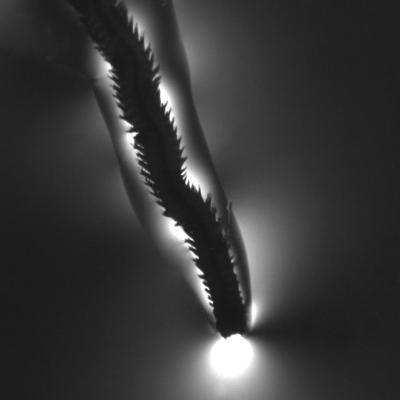Scientists at the APS 2020 March Meeting in Denver will share how studying animal motion has improved their understanding of animal behaviors.

Credit: Dorgan et al. 2007
DENVER, COLO., FEBRUARY 28, 2020 — Using physics to study different types of animal motion, such as burrowing worms or flying flocks, can reveal how animals behave in different settings. By using principles and technology from fields like fluid mechanics, scientists can track and measure animals in motion. At the 2020 American Physical Society March Meeting in Denver, researchers will present the various ways they quantify animal movement–and subsequently, better understand the animal world.
Social Behaviors in Flocks
Flocks seem to move as one unified organism, with each bird knowing its place and anticipating the group’s future movements. Although indistinguishable to the human eye, birds actually modify their flying behaviors based on the type of flock they are flying in.
“You can take the same bird with the same social structure in the same part of the world, and put them into two different contexts. They behave collectively in both cases, but the way they do so is not at all the same,” said Nicholas Ouellette, an environmental engineer at Stanford University.
He and his colleagues captured videos of jackdaws, a common species related to crows, flying in two types of flocks: transit flocks were when the birds all flew home to nest at night, while mobbing flocks were when the birds swarmed a predator.
The results indicate jackdaws in transit model their flight pattern after a set number of their neighbors–no matter how close or far those neighbors might be. However, mobbing jackdaws orient themselves by maintaining a set metric distance from surrounding birds. The birds’ interactions change based on flock type, suggesting the motives for some types of collective behavior influence animal behavior on an individual level.
Multiple Animals, One Neural Network
It can be difficult to identify and quantify animal behavior in the wild. A neural network developed by Talmo Pereira and his colleagues helps scientists track multiple animals in social settings and monitor their movement.
“The reason why we like to think of behavior in terms of motion is because most of what the brain does is control the body so that it can interact with the world,” said Pereira, part of a team in the Center for the Physics of Biological Function and the Neuroscience Institute at Princeton University. The imaging technique uses principles similar to those behind motion capture suits in Hollywood. But unlike actors, animals don’t have to wear specialized harnesses. Recently, the team modified their previous tracking method so it can distinguish each animal in a group even during close interactions.
Having a richer representation of animals’ movement adds to the quantitative understanding of behavior, according to Pereira.
A Photoelastic Stress Test for Worm Behavior
Deriving quantitative data from behavior requires flexible problem solving. Kelly Dorgan has been studying how marine worms burrow through muddy sediment and the forces they exert.
To replicate sea sediment’s physical properties, Dorgan, an ecologist at the Dauphin Island Sea Lab, turned to an unusual substitute. Jell-O has a similar fracture behavior, as sediment. This means that forces exerted by worms burrowing in muds can be directly calculated from forces measured in Jell-O
“Because I could measure forces, I came up with the first realistic measure of the energetic cost of burrowing,” said Dorgan. The results showed that despite the strength they use to burrow, worms actually expend very little energy in terms of increased metabolic rate because they move so slowly.
###
Behavioral Plasticity in Jackdaw Flocks
TIME/DATE/PLACE: 3:42 PM-3:54 PM, Monday, March 2, 2020, Room: 301
CONTACT: Nicholas Ouellette, [email protected]
Multi-Animal Pose Tracking Using Deep Neural Networks
TIME/DATE/PLACE: 9:24 AM-9:36 AM, Monday, March 2, 2020, Room: 303
CONTACT: Talmo Pereira, [email protected]
Worms in Jell-O: Using Photoelastic Stress Analysis to Measure Burrowing Forces
TIME/DATE/PLACE: 8:36 AM-9:12 AM, Thursday, March 5, 2020, Room: 502
CONTACT: Kelly Dorgan, [email protected]
ABOUT THE MEETING
The American Physical Society (APS) March Meeting is a major international conference and the largest physics meeting of the year. In 2020, the APS March Meeting will convene from March 2-6 at the Colorado Convention Center in downtown Denver.
Useful Links
Meeting website: https:/
Scientific program: http://meetings.aps.org/Meet ing/MAR20/APS_epitome
Press services: https:/
Hotel & Travel information: https:/
Press Registration
Complimentary registration is available to journalists for the express purpose of gathering and reporting news and information from the meeting. Staff reporters, freelance writers, and students are welcome to apply. Press credentials may be obtained by completing the form on this page: https:/
Press Conferences
All press conferences will take place in Room 608. If you are unable to attend, you may register to watch and ask questions online at https:/
Press Room
A press room for registered journalists will operate throughout the meeting in Room 610/612 and will offer complimentary coffee, breakfast, and lunch. The press room may be reserved for conducting interviews.
Hours
Monday – Thursday, 7:30 a.m. – 6:00 p.m.
Friday, 7:30 a.m. – 2:45 p.m.
Please contact the APS Press Office with any questions at [email protected].
ABOUT APS
The American Physical Society is a nonprofit membership organization working to advance and diffuse the knowledge of physics through its outstanding research journals, scientific meetings, and education, outreach, advocacy, and international activities. APS represents over 55,000 members, including physicists in academia, national laboratories, and industry in the United States and throughout the world. Society offices are located in College Park, Maryland (Headquarters), Ridge, New York, and Washington, D.C.
Media Contact
APS Press Office
[email protected]
301-209-3090




